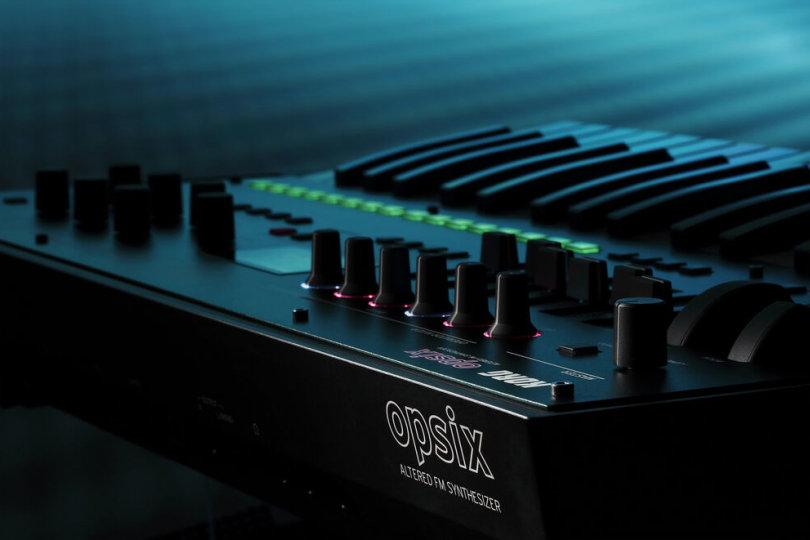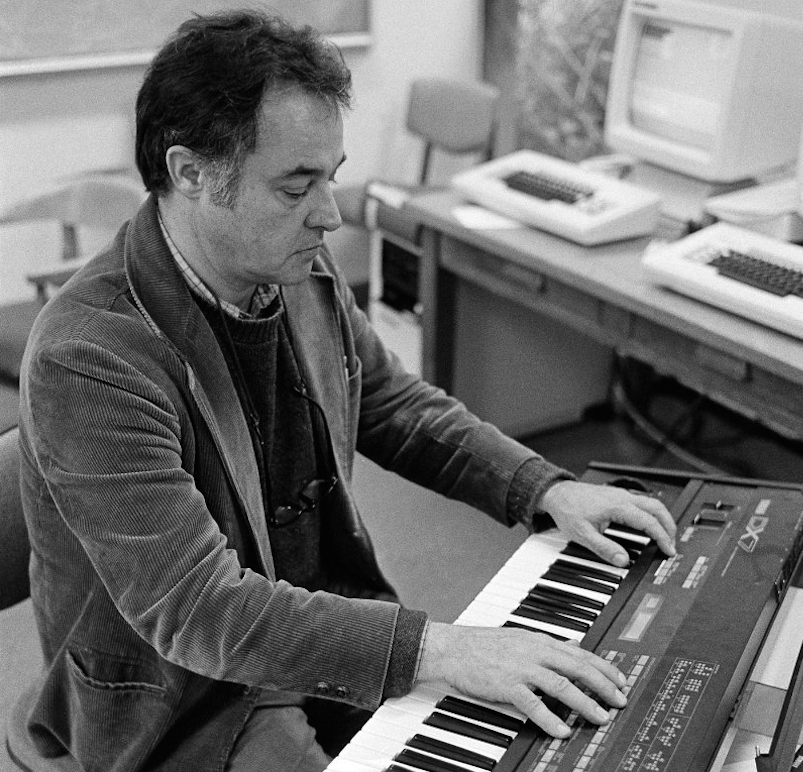
A Digital Delight, the Korg Opsix: Altered FM Synthesizer
Fabulous machine? Fu*#ing malevolent? Funky monkey? Frequency modulation? I have given up trying to define this machine. Before trying this “thing” I had never attempted to create sounds with an FM synth, if VCV Rack doesn’t count. Anyway, I wanted to explore something digital, something deeper than the traditional analogue machines I’d been working with, so I picked up the Opsix and for quite a while, just kinda stared at it. It looks pretty: coloured LEDs, an OLED screen, nice layout and a solid build. It is an inviting looking piece of hardware, but will I regret coming to the party?
I must state a disclaimer: this is going to be more of a 3-week hands-on expression of my experience, rather than a full-fledged review. I still don’t feel confident when it comes to sound design on the Opsix and am not in control of everything this thing spits at me. I believe I am a competent analogue user, but man, this thing can be overwhelming.

In the 1960’s Dr John Chowning at Stanford University developed a sound-synthesis technique called “frequency modulation.” To boil it all down to simplicity, FM synthesis combines waveforms to create more complex results—unlike subtractive synthesis which begins with a basic waveform and then selectively removes harmonics with envelopes, filters, etc to alter spectral components. Subtractive synthesis follows a fairly defined path and results can mostly be predicted when twisting knobs. You’ve got a sound in your head and, if familiar with subtractive synthesis sound design, can come fairly close within a few minutes. You know the route, whereas FM synthesis is a bit more like aimlessly tip-toeing through razor-sharp tulips while juggling a map, a cotton ball and a freight car full of steel bearings… in the dark. Anyway, in the ’80s, analogue synths were either too expensive or, in the case of more “budget” machines, too limiting. Things in the analogue world were becoming a bit stale. In 1980, Yamaha stepped up to the plate with their GS1 FM synth. It was not a big hit. However, two years later they came out with one of the most recognized and impactful synths ever, the DX7. Goodbye analogue, hello top-10 hits and a miserable decade or so of radio drivel (I was a punk at the time). Hundreds of thousands of units were sold commercially and are sought after even today. I really don’t know why. Programming the thing looks like a miserable endeavour. It was quite a preset decade, after all. Let’s fast-forward 40 years before my ’80s trauma awakens.
Enter the green dragon…
The Opsix has been classified by Korg as an Altered FM synthesizer. After spending a few weeks digging into it, I would say that is an accurate assessment. I had done my internet “research” prior to pulling the trigger on the Opsix. I had watched about a hundred videos, tutorials and reviews of other FM oriented synths: Elektron Digitone and Cycles, Korg Volca FM, SonicWare Liven XFM, etc. The Digitone looked great, but a bit pricey and lacking operators; the Cycles was too simplistic; the Volca too menu-divey; the Liven just seemed kinda weird to me. Korg, on the other hand, promised not only FM but a total of six forms of synthesis (now 7+ with the newest update) and a more user-friendly hands-on approach to something that had previously seemed a bit too daunting. I was looking for a digital Swiss army knife. I do believe I have found it.
The Opsix, at its foundation, is a six-operator FM synth. You choose an algorithm of the operators (assign carriers and modulators) and twist the ratio knobs and slide the amount/amplitude faders until you achieve your goal. Add envelopes, filters and effects to taste. However, the Opsix expands FM capabilities by giving you not only sine waves to work with, but an additional 21 waveforms as well. Each traditional waveform (sine, saw, triangle, square) has three different bit-rates to choose from and there are a slew of additive waveforms, pink/blue/white noise and combinations of all of the above. On top of the FM engine, the Opsix also has a ring-modulation operator (amplitude modulation), filter modulation operator (pitch tracking), filter mode operator (pitch tracking and cutoff modulation), waveshaping operator (folding back waveforms above a set threshold), effects operator (effects feeding operator input signals) and comprehensive virtual analogue possibilities. The crazy thing is that, with six operators, you can have each operator employing a completely different engine using different waveforms for each. Nuts. With the myriad of combinations, I still haven’t been able to figure out what and how what is affecting what. It is wonderful, challenging, but wonderful.
The fluff is the good stuff, but back to the familiar
When you have a steadier grasp of the Opsix’s foreign landscape of operators, their algorithms and waveforms, you can slide back into familiar territory with the rest of the synth’s functions. There are three global envelopes and three LFOs that can be applied to a patch, on top of the individual modulators for each operator. There are filter emulations for a more subtractive approach and the choice of filters is extensive. The highlights are the ms-20 and Polysix filters in a list of a variety of low-pass, high-pass, band and notch filters, among others. The ms-20 screams and the Polysix filter is great for pads. Korg has put a lot of effort into getting the filter section right. I doubt I could tell the difference between an analogue ms-20 filter and the Opsix’s emulation in a blindfold test. The ability to mix FM with subtractive synthesis is a nail hit right on the head by Korg.
The Opsix has a twelve-slot modulation matrix (virtual patch is what they call it), which enables you to apply any of sixteen modulation sources to over seventy-seven destinations. Other than on pure analogue synths, this seems to be the norm these days. On the Opsix, everything you would want to modulate can be modulated. Seemingly endless possibilities, a sound designer’s delight.
There is an arpeggiator and a sixteen-step sequencer. The mod matrix can be used to manipulate your arpeggios in interesting ways and, of course, the arpeggiator comes with all your favourite patterns (up, down, as played, random, up-down, etc.). When it comes to the sequencer, do not be fooled by having only sixteen steps. What is interesting about this sequencer is that each step has six-note polyphony and has a much greater resolution than at first glance. What this means is that if you slow down the clock as slow as it will go, add an arp to each individual step, punch in a few more notes (up to six) in each step and modulate each step till the cows come home. Although seemingly limited, you can stretch the sixteen steps to a seemingly endless loop.

The effects on this green machine are legion. You can have a total of three effects in your chain. There is only one series algorithm, as effects only go from 1 to 2 to 3. You can’t feedback effects into themselves and there is no variety in effect chain configuration, but the quality of the effects, themselves, is fabulous. There is a wide variety of modulation effects, amp models, delays, reverbs and more. Although not being able to choose from a series algorithm, I was never left wanting in the effects department.
I can’t tear myself away…
As I suggested in my disclaimer above, I feel like over the past three weeks I have only scratched the surface of what the Korg Opsix can do. However, I find myself sitting for hours noodling, turning knobs, sliding sliders and “menu diving”. Compared to what I have seen on other FM synths, everything on the Opsix does seem immediate. Even the menus are not convoluted and it seems like all is laid out in a fairly beginner-friendly way. However, I know that it is going to take me a couple more months to tame the beast. For example, I spent a few hours constructing a patch that was attempting to emulate the dirty tones my Wasp Deluxe puts out. I mixed FM, ring modulation, and filter modulation, applying a variety of 8-bit waveforms. After adding a bit of modulation to replicate oscillator drift, adding a touch of chorus and distortion, it was close… damn close. However, there was a weird short screech coming from the tail end of the sound, somewhere buried in a release envelope. It took me about an hour to pinpoint it and get rid of it. Experimentation, deconstruction, reconstruction and more experimentation. Sure, I could use the presets, but sound design is why we buy hardware.
I have a few wishes. Well, just one really. Aftertouch is available as a mod source, but the keyboard does not support aftertouch. I always apply aftertouch to control a bit of filter movement, etc. I do have all of my synths being controlled by my Deepmind (aftertouch), which is fine, but it would have been nice for the keyboard on the Opsix to offer it.
All in all, it is a lightweight, capable and beautiful looking machine. I am planning to keep at it until I know it. I am going to attempt to incorporate it into live performances with my crusty-punk band. I get the feeling that, once I learn its insides and outs, it is a synth that could be coaxed into producing any sound possible. A true digital Swiss army knife. I just hope I don’t cut myself.
For further investigation of the Opsix, I recommend a series by Oscillator Sink on Youtube. He is a wonderful instructor.
If you have found an error or typo in the article, please let us know by e-mail info@insounder.org.





